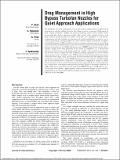Drag Management in High Bypass Turbofan Nozzles for Quiet Approach Applications
Author(s)
Shah, P.; Robinson, A.; Price, A.
Downloadturbo_136_02_021009.pdf (7.716Mb)
PUBLISHER_POLICY
Publisher Policy
Article is made available in accordance with the publisher's policy and may be subject to US copyright law. Please refer to the publisher's site for terms of use.
Terms of use
Metadata
Show full item recordAbstract
The feasibility of a drag management device that reduces engine thrust on approach by generating a swirling outflow from the fan (bypass) nozzle is assessed. Deployment of such "engine air-brakes" (EABs) can assist in achieving slower and/or steeper and/or aeroacoustically cleaner approach profiles. The current study extends previous work from a ram air-driven nacelle (a so-called "swirl tube") to a "pumped" or "fan-driven" configuration and also includes an assessment of a pylon modification to assist a row of vanes in generating a swirling outflow in a more realistic engine environment. Computational fluid dynamics (CFD) simulations and aeroacoustic measurements in an anechoic nozzle test facility are performed to assess the swirl-flow-drag-noise relationship for EAB designs integrated into two NASA high-bypass ratio (HBPR), dual-stream nozzles. Aerodynamic designs have been generated at two levels of complexity: (1) a periodically spaced row of swirl vanes in the fan flowpath (the "simple" case), and (2) an asymmetric row of swirl vanes in conjunction with a deflected trailing edge pylon in a more realistic engine geometry (the "installed" case). CFD predictions and experimental measurements reveal that swirl angle, drag, and jet noise increase monotonically but approach noise simulations suggest that an optimal EAB deployment may be found by carefully trading any jet noise penalty with a trajectory or aerodynamic configuration change to reduce perceived noise on the ground. Constant speed, steep approach flyover noise predictions for a single-aisle, twin-engine tube-and-wing aircraft suggest a maximum reduction of 3 dB of peak tone-corrected perceived noise level (PNLT) and up to 1.8 dB effective perceived noise level (EPNL). Approximately 1 dB less maximum benefit on each metric is predicted for a next-generation hybrid wing/body aircraft in a similar scenario.
Date issued
2013-09Department
Massachusetts Institute of Technology. Department of Aeronautics and AstronauticsJournal
Journal of Turbomachinery
Publisher
ASME International
Citation
Shah, P. et al. “Drag Management in High Bypass Turbofan Nozzles for Quiet Approach Applications.” Journal of Turbomachinery 136, 2 (September 2013): 021009 © 2014 ASME
Version: Final published version
ISSN
0889-504X